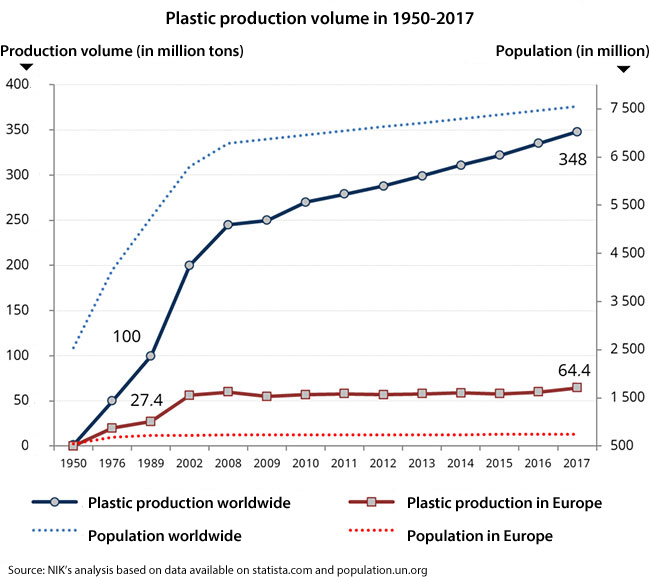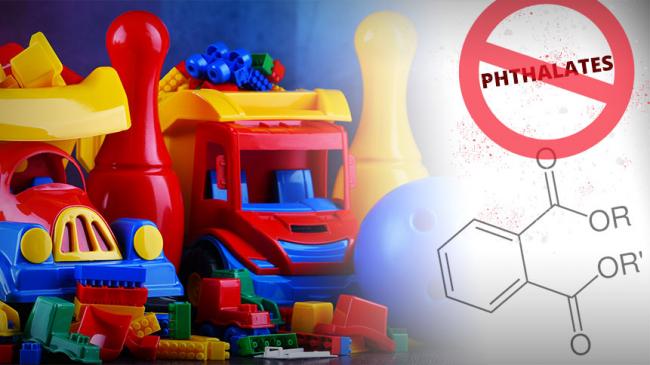An increasing number of studies shows that plastic is a huge problem not only for the environment but also for human health. The main issue is not the plastic itself but additives of different kind which are found in it: plasticisers, fillers, colourants, stabilisers and other chemicals used to give plastic desired properties. Recently there has been more and more media reports about microplastic present in food and drinking water. Microplastic along with household sewage (where it is produced among others by rubbing synthetic clothes off while being washed) goes to the rivers and then to the seas and oceans. Afterwards, it enters food chains and – when people eat fish and sea food – it goes back to human organisms. The substances found in plastic also have negative impact on youngest kids using plastic toys: unwanted substances may get into their organisms when they take toys in their mouth. Unfortunately, the production of plastic is growing year after year.

In Poland, depending on the type of plastic products, there are two authorities: the State Sanitary Inspectorate and the Trade Inspection Authority. Both of them verify the compliance with legal provisions defining the content of hazardous substances in plastic. The first authority controls products which have contact with food (e.g. packagings and dishes), the other controls other products for which such norms have been set - toys in particular.
Key audit findings
The controls of the Office of Competition and Consumer Protection (OCCP) focused on the safety of plastic products, especially toys made of polyvinyl chloride (PVC) in terms of the content of phthalates. NIK has pointed to limited testing capacity of the OCCP laboratories. Only two in eight laboratories of the Office of Competition and Consumer Protection examined the content of various substances in plastic products. In the audited period, since they were not capable of making some tests, they had to be outsourced to four external laboratories.
In 2017–2019, about 200 tests for phthalates in PCV toys were made, thus implementing the testing plans (collection of 200 samples was planned in 2017 and in 2018–2019 it was about 160 samples each year). In case of plastic toys, the number of samples containing non-allowed amounts of phthalates ranged from 18-26.6 percent. According to NIK the number of tests resulting from the testing capacity of the Office of Consumer Protection and Competition was small, especially considering small volume of the toy market and easiness of coming across hazardous products (according to the data of the National Revenue Administration the number of bills of entry for plastic toys in 2017–2019 in Poland exceeded 40 thousand).
NIK has also pointed to long duration of toy testing for phthalates – the average waiting time for the test results in 2017–2019 ranged from 25 to 34 days (from the date of delivering samples to the laboratory). Though, with adequate human resources and equipment, such tests could be made within 5-7 days. Some toys with excessive phthalate concentration were sold while waiting for the test results, thus posing a threat to children. During the NIK audit it was found that the total of 451 hazardous toys were sold.
In such cases the Office of Consumer Protection and Competition took efforts to withdraw such toys from the market and return them to sellers. However, the termination of proceedings on hazardous products did not mean that consumers returned the purchased toys.
The President of the Office of Consumer Protection and Competition properly conducted proceedings on plastic products that did not meet the requirements and aimed to withdraw them from the market. In line with principles defined by the law, he ran the register of such products, although in six cases entries about hazardous toys were made with over two to nearly five months’ delay.
The Chief Sanitary Inspector planned controls and monitored plastic materials and products designed for food contact with a view to human health protection. He also considered risk analysis based on the previous official controls, expert opinions and notifications in the Rapid Alert System for Food and Feed (RASFF). Apart from that, he implemented the procedure for controlling materials and products designed for food contact. Due to the absence of relevant provisions in the EU and Polish law, the State Sanitary Inspectorate authorities did not include tests of drinking water and food for microplastic in its planned activities. Only on 12 January 2021, the revised Drinking Water Directive adopted by the European Parliament and the EU Council came into force. According to that Directive, microplastic content in water can be now monitored. The European Commission was given the time to adopt the relevant testing procedure by 12 January 2024.
In 2017–2019, the State Sanitary Inspectorate authorities nationwide tested 4263 samples of materials and products designed for food contact. Since there is no obligation to separately record particular types of products and materials designed for food contact it should be underlined that these data cover not only plastics but also other products (e.g. glass and metal packagings). NIK has stressed that the percentage of disqualified products was small – from 0.6 to 1.9 percent. It shows that products designed for food contact on the Polish market, including the ones made of plastic, are mostly safe. Besides, NIK has positively evaluated the fact that more than 1600 factories making materials and products designed for food contact (i.e. about 25 percent) are now subject to annual controls.
The NIK audit revealed that because of financial problems in one laboratory in 2019, as many as 47 of 50 planned tests were not made (the tests were related to Tenax - a compound simulating dry and frozen foods, used to test specific migration of substances from packagings). That was a laboratory of the Provincial Sanitary and Epidemiological Station in Gdańsk (PSES), the only one in 16 labs of the State Sanitary Inspectorate which made such tests. The Chief Sanitary Inspector repeatedly requested the President of the Council of Ministers, the Minister of Health and the Pomeranian Governor to provide more funds for the PSES in Gdańsk. The requests proved ineffective in the audited period, though, and the tests were renewed in 2020. The Chief Sanitary Inspector explained that reducing the number of such tests for one year did not carry significant risk for consumers. NIK did not share that view, however, and pointed to inconsistency on part of the Inspector who – in his requests to the Minister of Health and the Pomeranian Governor - indicated that the underperformance of tests was the reason why Poland failed to meet its obligations under the EU law.
Besides, the equipment shortages in two Provincial Sanitary and Epidemiological Station laboratories resulted in prolonged testing time (from 28 to 45 days) of three product samples (being the object of the RASFF notifications). As a consequence, in one case the sale of 12 spoons was noted in which excessive migration of hazardous, potentially carcinogenic chemicals (aromatic amines) was identified.
As a rule, relevant authorities properly and immediately responded to notifications in two systems on hazardous plastic products: RASFF (Rapid Alert System for Food and Feed) and RAPEX (Rapid Exchange of Information System). In the audited period, the RASFF National Contact Point, being part of the Chief Sanitary Inspectorate, reviewed the total of 44 cases related to plastic materials and products designed for food contact and reported to the system. The RASFF notifications were reviewed immediately but were not always verified by means of on-site inspections, which NIK has found unreliable.
Recommendations
To the President of the Council of Ministers:
- to define demand as to the number of product samples to be obligatorily covered by chemical safety testing and to adjust appropriately the testing capacity of the OCPC laboratories;
- to eliminate barriers related to organisation and analytical equipment preventing the State Sanitary Inspectorate authorities from fully implementing their plans to collect samples and prolonging the waiting time for test results.
To the President of the Office of Consumer Protection and Competition:
- to shorten waiting time for the results of toy tests for phthalate content to minimise the risk of selling products hazardous for children.
To the Chief Sanitary Inspector:
- to update the RASFF procedures with the principles of providing information obtained by the State Sanitary Inspectorate authorities from entrepreneurs without making field inspections.


